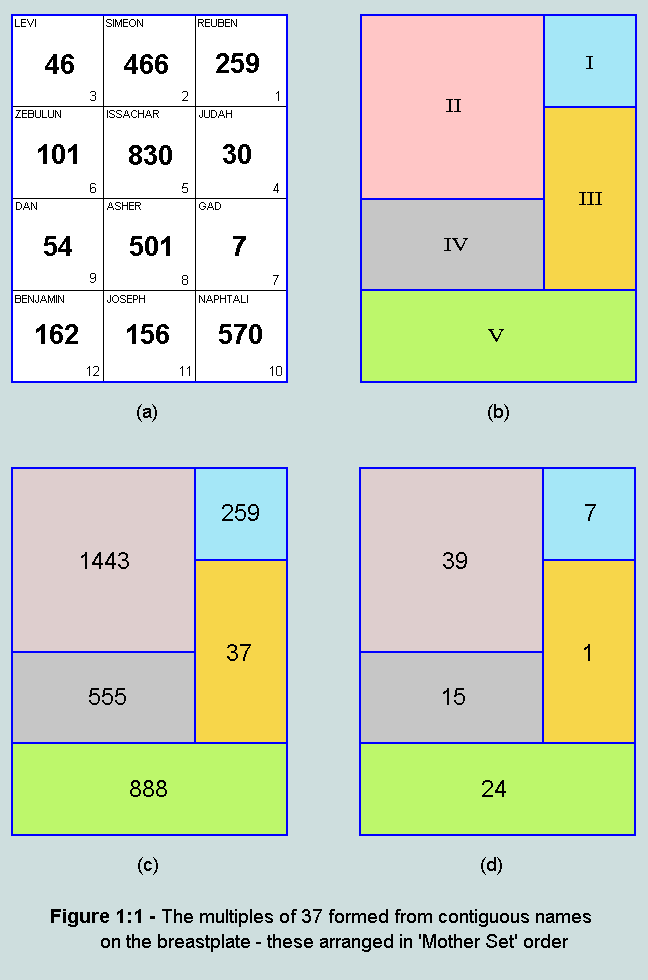
Double Indemnity
1.1 - Introduction
1.2 - The contiguous blocks of 37
1.3 - The house of Leah
1.4 - Some apposite numerical geometry
1.5 - Additional features of 2521
1.6 - Additional features of 661
1.7 - Addendum
- 1 - The Twelve Sons of Israel
- 2 - The Numerical Interpretation of Hebrew words
- 3 - The Numerical Interpretation of Greek words
- 4 - An Introduction to Numerical Geometry
- 5 - An Introduction to Midpoint Sequences
- 6 - The Names on the Jewels of the Breastplate
- 7 - The Triple Marker
1. Introduction
At Exodus 28, instructions were given to Moses for the fashioning of the breastplate of judgment, a device to be fastened to the outer garments of the high priest for his service within the tabernacle. Twelve precious stones were attached to the breastplate, each stone being engraved with the name of one of the twelve children of Israel, according to their birth order (see Appendix 1).
As a grid, the breastplate - with its division of 12 names engraved upon 4 rows of 3 stones - doubles as a template whereupon the names of the 12 tribes of Israel (not quite the same as the 12 children of Israel) might be superimposed, the condition being that it remain representative of birth order.
In an earlier page, An Oracle Restored, we investigated the matrix of integers formed from the breastplate when overlaid with the names of the 12 tribes, after their birth order. In particular, it was observed that the 12 Characteristic Values (hereafter, CVs) of the breastplate names divided into six contiguous blocks of multiples of the number 37. Remarkably, when the breastplate is overlaid with the names of the sons of Israel - an operation which sees the appearance of the names of Levi and Joseph and the deletion of Ephraim and Manasseh - a similar division occurs into five contiguous blocks of multiples of the number 37. This time the birth order is along matriarchal lines.
For the purposes of this analysis we will use the matriarchal grid, hereinafter referred to as the Mother Set (MS). We will see that the MS contains an abundance of numero-geometrical features, many of which divide the grid symmetrically and in highly symbolic ways, the united testimony leaving the observer in no doubt as to the nature and identity of the God of Israel.
2. The contiguous blocks of 37
In keeping with the format presented at 'An Oracle Restored', we observe the following attributes, predicated upon 37 and its multiples in contiguous blocks.

At (a) we have the MS matrix and observe that it may be internally divided into the 5 regions - I, II, III, IV, and V - as at (b) - the sum of the CVs within each region as a multiple of 37 - as at (c) - and again at (d) - where the multipliers are recorded. A glance at these multipliers reveals that the first 5 multiples of 8 and one other may be constructed by combining contiguous regions, thus:
I + III = 8; III + IV = 16; V = 24; I + III + V = 32; III + IV + V = 40 = II + III; II + III + V = 64
Referring to (c), these regional sums are, respectively, 296, 592, 888, 1184, 1480 and 2368. These are important features: 296 being the CV of the 7th word of Genesis 1:1 (meaning 'earth') and factor of both name and title of our Lord - matters to be discussed later in more detail. Such is the significance of these attributes of the MS matrix that they are here repeated graphically:
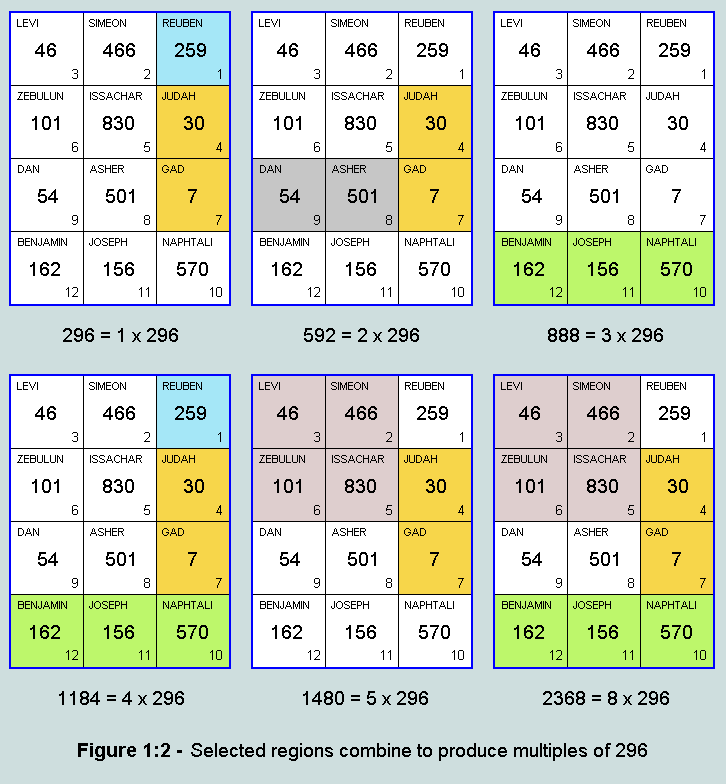
3. The House of Leah
The first six CVs represent the six sons of Leah (a). The sum of their names is 1732.
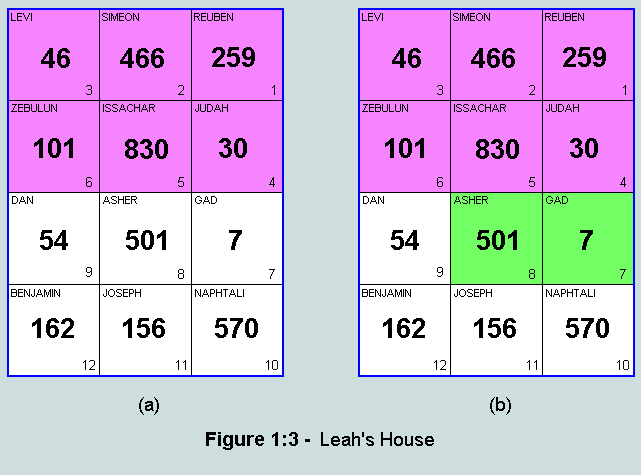
The next two CVs represent Leah's surrogate children, thus completing her house of eight sons (b). These two names, when represented with 4 digits to coincide with the sum of the earlier six, is 0508.
Concatenating these sums representing the House of Leah yields 17320508. Remarkably, these are the first 8 digits of the infinite string for the square root of 3, i.e. 1.7320508...
4. Some apposite numerical geometry
[A background to this section may be found in Appendix 4]
To find a highly-integrated structure of numerical geometry in a small, apparently random, set of natural numbers speaks loudly of design. The particular structure now presented for consideration may be best described by the following sequence of outlines:
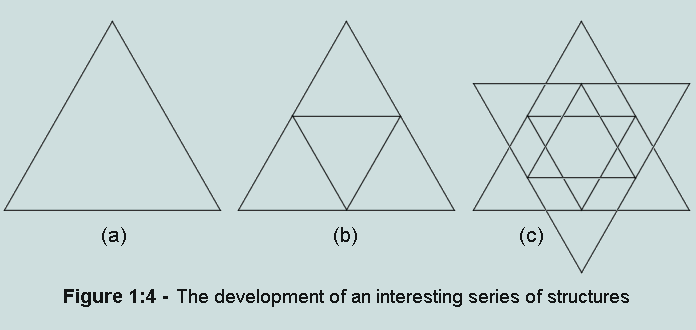
At (a) we have an equilateral triangle [T(i), say] within which a second [T(j), say] is inscribed - as depicted at (b); this is then united with an inverted copy of itself to produce the symmetrical structure (c) which essentially consists of two nested hexagon/hexagram pairs [X(m)/Y(m) and X(n)/Y(n), the outer and inner figures, respectively].
To translate such a structure into a numero-geometrical format we first need to ensure that the triangle T(i) is centred (i.e. is a G-triangle), and that each of its sides comprises an odd number of counters (i.e. its order number must be odd). Observe that the subscripts i, j and m are simple functions of n, the order number of the inner hexagon/hexagram pair, thus:
j = 3n - 2; i = 2j - 1 = 6n - 5; m = (6n - 3)/3 = 2n - 1
Of particular interest to the matter now before us is the 10th structure proper in the infinite series - generated by setting n = 11. It then follows that j (dimension of the smaller triangle) = 31; i (dimension of the larger) = 61; m (dimension of the larger X/Y pair) = 21; n (dimension of the smaller X/Y pair) = 11. These figures are depicted below.
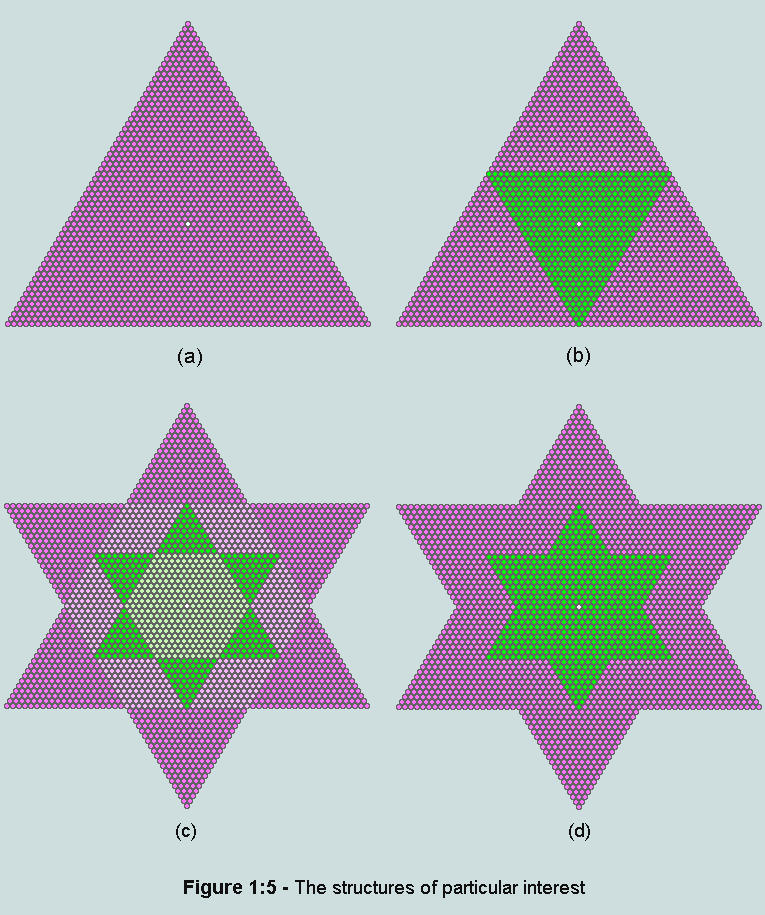
At (a) we have a representation of the 61st triangular number [designated T(61)]*; it comprises 1891 counters - its centroid counter rendered white. The same is shown at (b) - now inscribed with the 31st triangular number [T(31)] of 496 counters. This number is significant in being 3rd perfect number. At (c) we depict the union of this figure with an inverted copy of itself. Observe that 4 new figures are now visible, viz the hexagon/hexagram pairs X(21)/Y(21) - represented in two shades of pink - and X(11)/Y(11) - represented in two shades of green. These figures comprise 1261/2521 and 331/661 counters, respectively. In the interests of clarity the nested hexagrams are again shown at (d) - comprising, respectively, 2521 and 661 counters.
Observe that the sum of these hexagrams is 3182, or 86 x 37, i.e. the total represented by the 12 names on the breastplate. Its factors relate directly to significant features of Genesis 1:1 where we find 37 to dominate the proceedings, and 86 to be the CV of 'Elohim' - 3rd word of the Bible and first name of God.
5. Additional features of 2521
Both members of the related pair 1261/2521 are bifigurate, i.e. each possesses an alternative symmetrical form - as is made clear in the following diagrams.
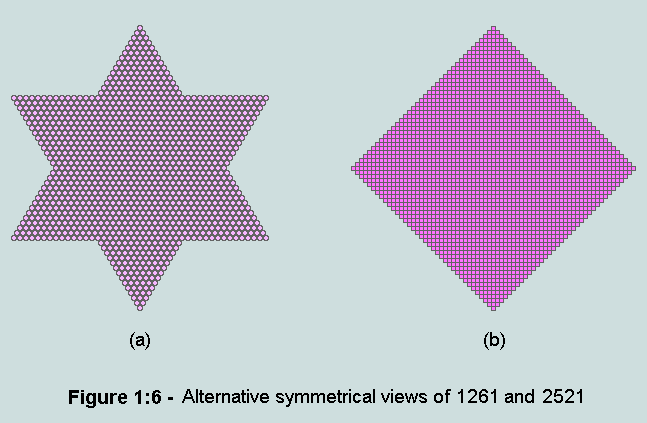
At (a), we see 1261 as 15th hexagram, and at (b), 2521 as 36th diamond (which may be inscribed in the 71st square). These are rare features - compounded by the fact that they relate to a particular X/Y pair.
In its capacity of 2520-around-one, we note 2520 is the LCM of all single-digit numbers
Observe that 1261-as-hexagram is formed from the self-intersection of the 43rd triangle, 946, while the hexagram of 2521 is formed from the self-intersection of the 61st triangle, 1891; these triangles are related in that 946 is the midpoint of 1891; this means that 1891 may be reconfigured as an hour-glass, thus:
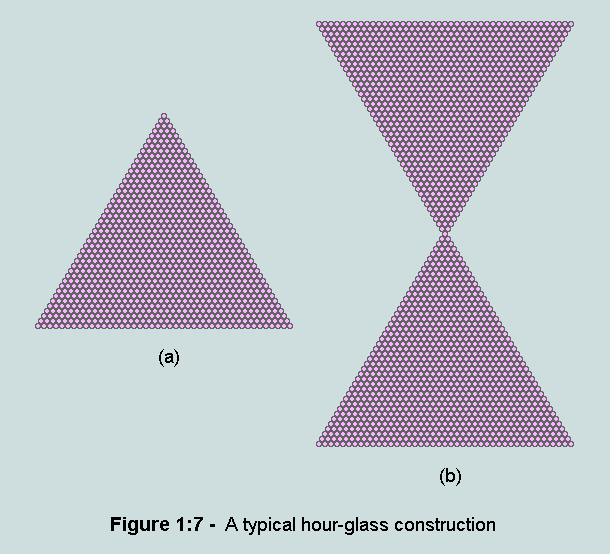
Here, (a) is a representation of 946, the 43rd triangle, and (b), of 1891, the 61st triangle. Observe that an hour-glass very rarely equals a triangle - indeed, there are only 5 non-trivial examples of this phenomenon in the first 70,000 triangular numbers. Significant, then, that the MS has discovered one!
1891 factorises as 61 x 31, and segments into an inverted triangle of 496 (third perfect number) surrounded by three triangles of 465 each; this structure is depicted in Fig.1:5 (b) above. The sum of the order numbers of these 4 triangles is (31+30+30+30), or 121
6. Additional features of 661
The 11th hexagram of 661 contains the 11th hexagon of 331 [see the figures shaded green in Fig.1:5(c) above]
The hexagon of 331 is a 2D representation of the 11th cube of 1331 (also written as 11 x 121)
Just as the hexagon of 331 sits at the heart of Fig.1:5(c), so its 3D counterpart - the 11th cube of 1331 - lies at the heart of the MS, thus:
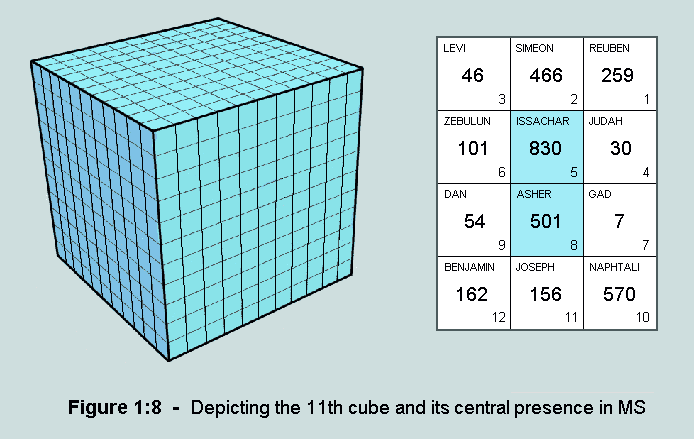
The hexagram of 661 is formed from the self-union of the 31st triangle, 496 [Fig.1:5(c) above]
496 factorises as 31 x 16; as a triangle it segments (as before) into an inverted central triangle of 136 surrounded by three of 120 - the sum of their order numbers being (16+15+15+15), or 61
7. Addendum
A consideration of the data gathered so far reveals several points of convergence:
The respective triangles which self-unite to form the two hexagrams, 2521 and 661, whose sum is 3182 - the MS matrix total - are of order 61 and 31
The first of these, 1891, factorises as 61 x 31
The second, 496 (3rd perfect number), factorises as 31 x 16 (digit reverse of 61), and is centrally positioned within 1891
The two CVs blend on the breastplate to produce the arresting visual of capital Alpha, thus:
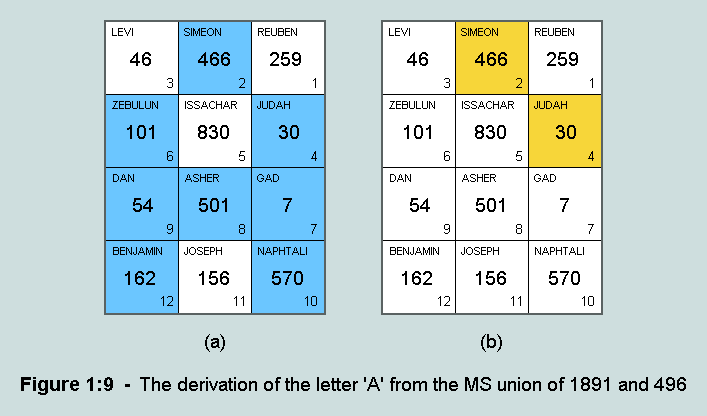
At (a), we depict the total of the symmetrically-disposed tiles totalling 1891; and at (b), those totalling 496 which clearly represent a subset of (a). Their union therefore is represented by (a), where we see a stylised form of capital Alpha. This, of course, is one of the titles of The Lord Jesus Christ.
the 43rd triangle enters proceedings as, (i) key figure in depiction of 1891 as hour glass; and, (ii) template for an alternative figuring of 1261 as hexagram
the order of triangles composing 1891 sum to 121; those for 496 sum to 61
* See Appendix 7 for further details concerning 1891 - the 61st triangle
2006-03-11
email: vernon.jenkins@virgin.net
> Part 2